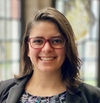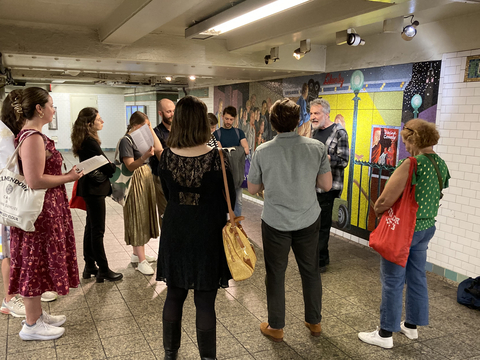Dante Underground: Working Group Brings Inferno to Life in NYC Subway
Deep beneath the neon frenzy of Times Square, a group of students, professors, and Dante aficionados turned a bustling transit hub into an impromptu stage for medieval poetry. Last semester, the Dante Working Group, a student-led association sponsored by the Whitney Humanities Center at Yale, organized “Dante Underground”—a reading of Dante Alighieri’s Inferno in the Times Square subway station.
The idea originated years ago at an annual meeting of the Dante Society of America, where SUNY Geneseo professor Ron Herzman humorously suggested that members should busk Dante’s poetry in the subway. Later, he and Alejandro (Alex) Cuadrado of Italian Studies at Yale joked about the perfect location: near Jack Beal’s mosaic “The Onset of Winter” on the mezzanine level of the Times Square station. The mosaic mural depicts the underworld myth of Persephone and includes a poster for an Italian silent-film adaptation of The Divine Comedy.
Although this conversation began in jest, the concept resonated with the Dante Working Group. As Alex and his colleague Giacomo Berchi, of Italian Studies and Early Modern Studies, sought innovative ways to engage with Dante’s work beyond the classroom and traditional academic talks, they returned to the idea of Dante busking. In his role as working group coordinator, Giacomo worked with the Whitney Humanities Center to secure funds for travel expenses, ensuring that everyone from Yale who wanted to be part of this unique experience could join.
What made the event particularly special was the diversity of the group. Many attendees were colleagues from universities in New York City, including NYU, CUNY, and Columbia, who had heard about the event through social media and word of mouth. Participants, ranging from the president of the Dante Society of America to an Italian woman from Yale School of Medicine, took turns reading cantos, both in Italian and English.

Readers selected passages they felt drawn to, sometimes altering their choices based on the ambient noise levels—like Alex, who chose a particularly dramatic canto to project over a nearby pan flute player. For two hours, their voices mingled with the din of the station—announcements, footsteps, conversations, trains—creating a complex auditory landscape. This only amplified the event’s thematic resonance, evoking the “horrid sounds” described in Dante’s depiction of Hell.
Reflecting on the event, Alex noted the appropriateness of the location: “The idea that Shakespeare can be in the park, but Dante—at least his Inferno—should be underground” seemed to capture the essence of the endeavor.
Dante Underground achieved something at once playful and profound. The readers managed to disrupt routine, to make the familiar strange and, in doing so, to open a space for reflection.
The success of Dante Underground has left participants eager for more. Many expressed hope that reading Dante in public will become an annual tradition, potentially expanding to include the rest of The Divine Comedy: Purgatorio at the Dante statue near Lincoln Center or Paradiso in Central Park.


